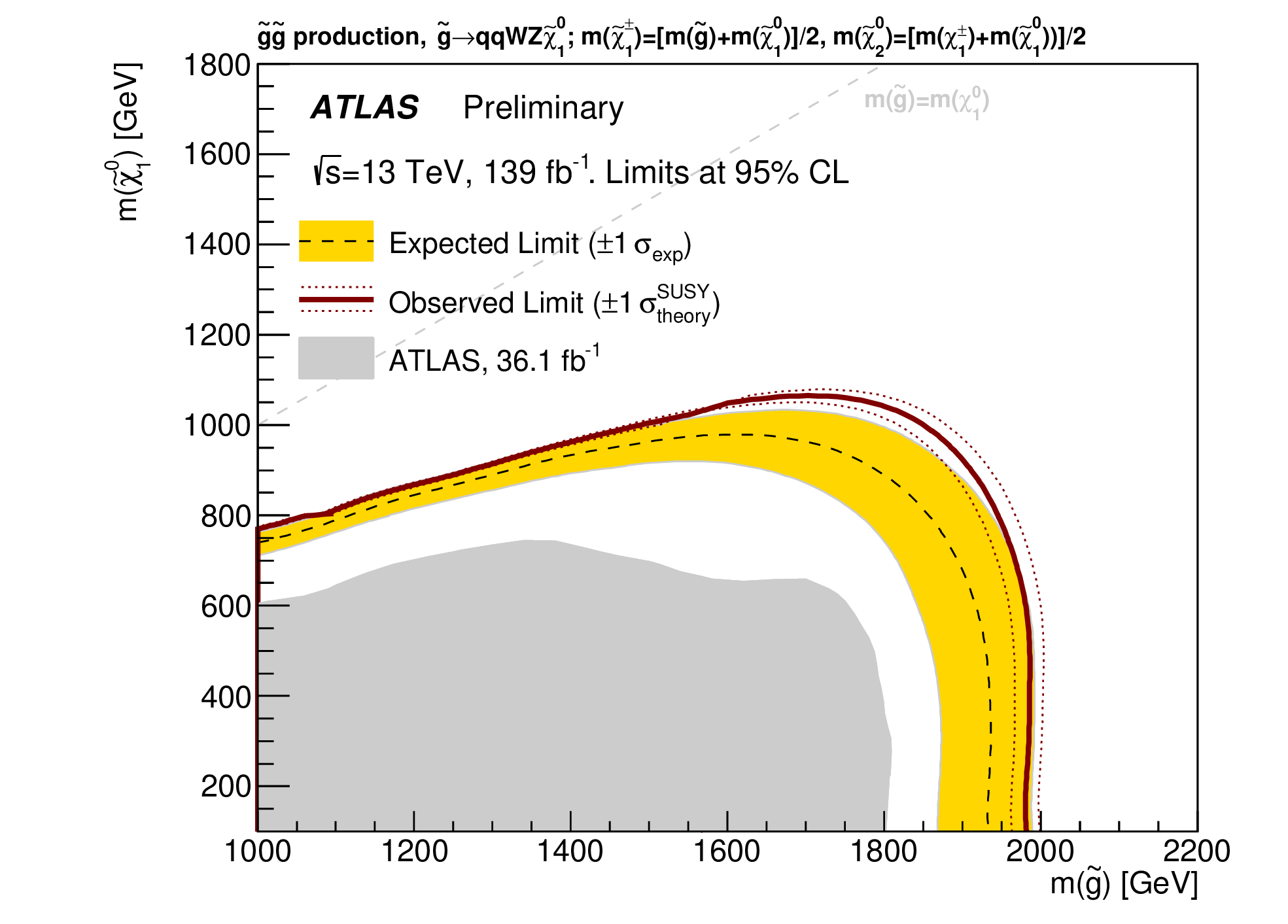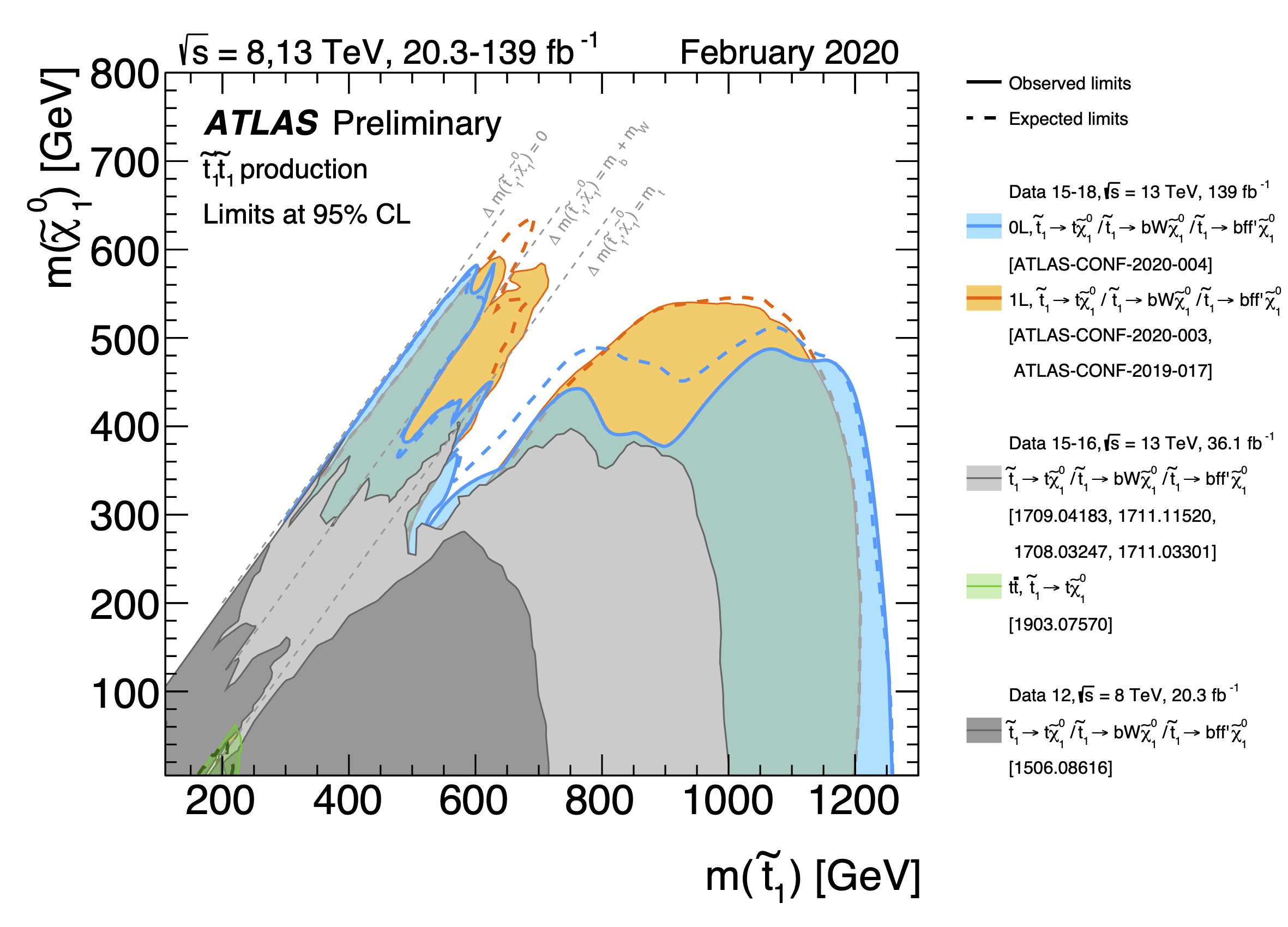Searching for natural supersymmetry using novel techniques
18 February 2020 | By


In new results presented today at CERN, the ATLAS Experiment’s search for supersymmetry (SUSY) reached new levels of sensitivity. The results examine a popular SUSY extension studied at the Large Hadron Collider (LHC): the “Minimal Supersymmetric Standard Model” (MSSM), which includes the minimum required number of new particles and interactions to make predictions at the LHC energies. However, even this minimal model introduces a large amount of new parameters (masses and other properties of the new particles), whose values are not predicted by the theory ("free parameters").
To frame their search, ATLAS physicists look for “natural” SUSY, which assumes the various corrections to the Higgs mass comparable in magnitude and their sum close to the electroweak scale (v ~ 246 GeV). Under this paradigm, the supersymmetric partners of the third-generation quarks (“top and bottom squarks”) and gluons (“gluinos”) could have masses close to the TeV scale, and would be produced through the strong interaction at rates large enough to be observed at the LHC.
At today’s CERN LHC seminar, the ATLAS Collaboration presented new results in the search for natural SUSY, including searches for top squarks and gluinos using the full LHC Run-2 dataset collected between 2015 and 2018. The new results explore previously uncovered, challenging regions of the free parameter space. This is achieved thanks to new analysis techniques improving the identification of low-energy (“soft”) and high-energy (“boosted”) particles in the final state.
Today's new results examine the full LHC Run-2 dataset, collected between 2015 and 2018, to significantly extend the sensitivity of natural supersymmetry searches.
ATLAS’ search for top squarks was performed by selecting proton–proton collisions containing up to one electron or muon. For top-squark masses less than the top-quark mass of 173 GeV (see Figure 1), the resulting decay products tend to be soft and therefore difficult to identify. Physicists developed new techniques based on charged-particle tracking to better identify these decay products, thus significantly improving the experimental sensitivity. For larger top-squark masses, the decay products are boosted, resulting in high-energy, close-by decay products. Physicists improved the search in this regime by using, among other techniques, more precise estimates of the statistical significance of the missing transverse momentum in a collision event.
The new search for gluinos looks at events containing eight or more “jets” – collimated sprays of hadrons – and missing transverse momentum generated by the production of stable neutralinos in the gluino decays, which, similar to neutrinos, are not directly detected by ATLAS. Physicists employed new reconstruction techniques to improve the energy resolution of the jets and the missing transverse momentum, allowing them to better separate the putative signal from background processes. These take advantage of “particle-flow” jet algorithms that combine information from both the tracking detector and the calorimeter system.
ATLAS physicists also optimised their event-selection criteria to enhance the contribution of possible SUSY signals compared to the Standard Model background processes. No excess was observed in the data. The results were used to derive exclusion limits on MSSM-inspired simplified models in terms of gluino, top-squark and neutralino masses (see Figure 2).
Figure 2: Updated exclusion limits on (left) gluino and (right) top-squark production including the new results presented by ATLAS at the CERN LHC seminar today. (Image: ATLAS Collaboration/CERN)
The new analyses significantly extend the sensitivity of the searches and further constrain the available parameter space for natural SUSY. The exclusion of heavy top squarks is extended from 1 to 1.25 TeV. The search continues.
Learn more
- CERN LHC Seminar: Constraining natural supersymmetry with the ATLAS detector by Jeanette Miriam Lorenz
- Search for new phenomena in final states with large jet multiplicities and missing transverse momentum using 13 TeV proton-proton collisions recorded by ATLAS at Run 2 of the LHC (ATLAS-CONF-2020-002)
- Search for new phenomena with top quark pairs in final states with one lepton, jets, and missing transverse momentum in 13 TeV proton-proton collision data with the ATLAS detector (ATLAS-CONF-2020-003)
- Search for a partner of the top quark in the all-hadronic tt¯ plus missing transverse energy final state at 13 TeV with the ATLAS detector (ATLAS-CONF-2020-004)
- Soft b-hadron tagging for compressed SUSY scenarios (ATLAS-CONF-2019-027, see figures)
- Jet reconstruction and performance using particle flow with the ATLAS Detector (arXiv: 1703.10485)
- See also the full lists of ATLAS Conference Notes and ATLAS Physics Papers.





